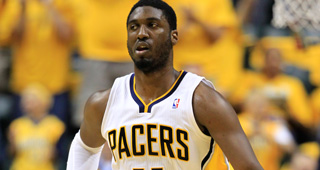There is no denying that Roy Hibbert has been atrocious on the offensive end this season after signing a four-year, $58 million contract with the Indiana Pacers last July. His defense has been tremendous in protecting the rim for the NBA’s highest rated group -- fourth in blocks (2.6) and second in Defensive Rating (96.0) -- but his poor play on the other end of the floor has garnered more attention.
Hibbert has never employed a vast array of offensive moves or been extremely agile, but he made such strides over his first four professional seasons that his ineptitude with the basketball has been alarming. Through 50 games, Hibbert has a True Shooting Percentage of .450 (down from a career-high .539 last season) and an effective field goal percentage of .417 (down from a career-high .497 last season), both of which are career lows.
Shooting 41.7 percent from the floor is poor for an NBA player, let alone a center. Hibbert has a jump shot despite his size, but it hasn’t necessarily been his play away from the basket that has been ugly. Last season, he had an eFG% of .263 on jumpers. This season that percentage is .281. Those shots clearly aren’t his bread-and-butter and he has attempted 34 percent of his shots on jumpers, up from 31 percent in 2011-12. However, that accounts for a small amount of his inefficiency.
The biggest discrepancy between Hibbert’s numbers this season and last has been on his close attempts, according to 82games.com. Last season, 56 percent of his shots were “close” attempts and his eFG% was .598. This year just 45 percent of his attempts are “close” and his eFG% is down significantly (.467).
Frank Vogel deserves credit for not diverting the offense away from Hibbert as he struggles. It helps that the Pacers are winning despite playing without Danny Granger or the Hibbert they enjoyed during the lockout-shortened campaign. Hibbert’s shot attempts are almost identical (10.3 to 10.2), but he is getting to the line much less.
A good free throw shooter for a big man (.723 for his career), Hibbert shot a career-high 3.7 foul shots last season. He’s hovering around a career-low with 2.2 attempts per game this year. That makes sense when you isolate his increase in jumpers (+3 percent) and decrease in close looks (-11 percent).
It also appears as though Hibbert has had some poor luck around the rim. He has missed a number of tip shots. In 2011-12, 82games.com classified 7 percent of his shots as tips and he had an eFG% of .408. This season, 15 percent of his attempts have come on “tips” and he has an eFG% of .400.
The difference in eFG% is miniscule, but the attempts have spiked. There are a few explanations for this, the most obvious of which is the year David West is having for Indiana. Further removed from a major knee injury and with shots to absorb with Granger out, West has seen his shot attempts increase 34.3 percent to 14.5 per game. That has given Hibbert more offensive rebound and tip chances, which is reflected in his glass work. He ranks third in the league with a 15.3 ORB%.
You could argue in Hibbert’s favor that things should get easier when Granger returns, but there have been plenty of other threats for opposing defenses to key on this season. West has played at an All-Star level, Paul George has become a star while earning his first All-Star bid and George Hill is third on the club in scoring (14.7).
The numbers still don’t look good, but the worst does seem to be behind Hibbert. He shot 37.8 percent and 40.7 percent from the field in November and December (30 games), respectively. He rebounded well in January, hitting 46.3% of his shots and so far in February he’s at 42.6 percent shooting.
Looking deeper into his splits, his ability to handle the difficult NBA schedule doesn’t appear to be an issue. He is shooting 46.6 percent in the second (or third) night of a back-to-back and just 36.8% on with two days of rest. He had the second-best game of his season on Wednesday night against the 76ers, posting 18 points and 14 rebounds on 8-for-20 shooting on the third night of a back-to-back-to-back created by a snow storm in December. He played more than 30 minutes in all three games as the Pacers went 3-0 and a seven-game high 33:55 in Philadelphia.
“I’m not having the offensive season that I want to have, but I’ve been working on trying to get back into a groove,” Hibbert told me in January. “Paul [George], David [West] and George [Hill] have been doing a great job. I’ll continue to work to get my offensive numbers up and the numbers should work themselves out.”
Since talking with Hibbert about his struggles on Jan. 2, he is averaging 10.8 points, 9.1 rebounds and 2.4 blocks on 44.8% shooting. Over that stretch, he’s attempted just 39 free throws (2.2 per game).
The Pacers are in the middle of the pack in free throw attempts and 27th in field goal percentage (43 percent). It stands to reason that Vogel would prefer Hibbert to worry more about taking better shots (and making them) instead of trying to force his way through contact to earn trips to the line.
The remainder of the month will bring a significant test for Hibbert. He will face off against Brook Lopez, Tyson Chandler, Andrew Bogut, DeAndre Jordan and Detroit’s combination of Andre Drummond and Greg Monroe (twice) before the calendar turns to March.
He may also get an All-Star teammate back and see a surge of confidence following Wednesday’s performance and Indiana’s stretch of seven wins in their last 10 games.



